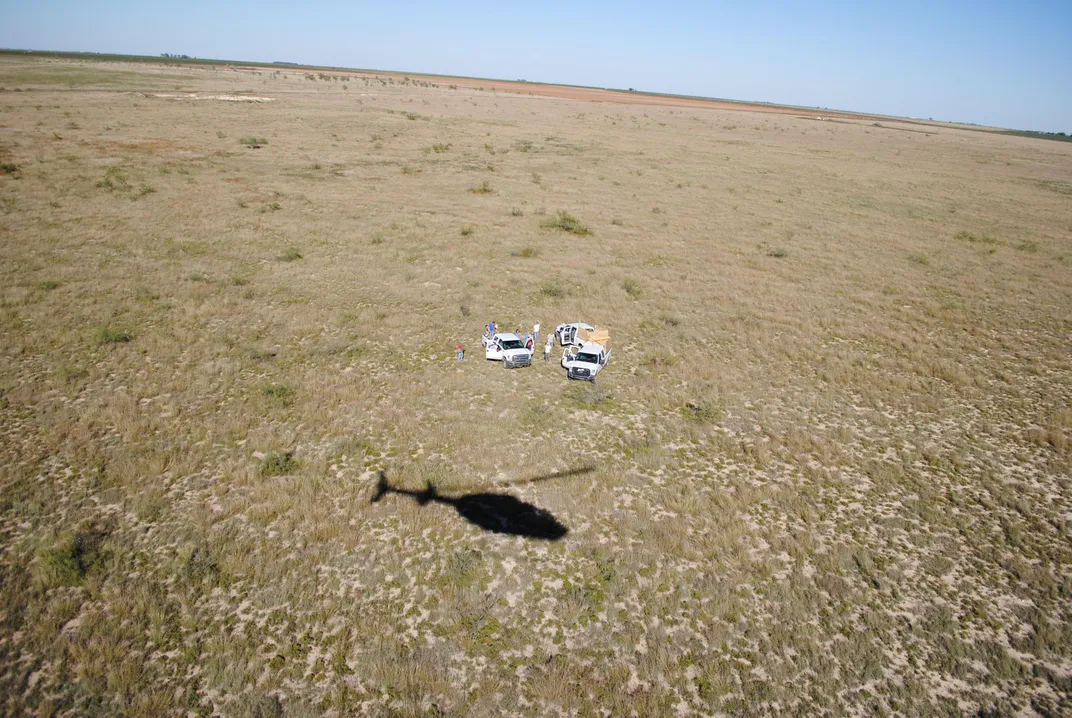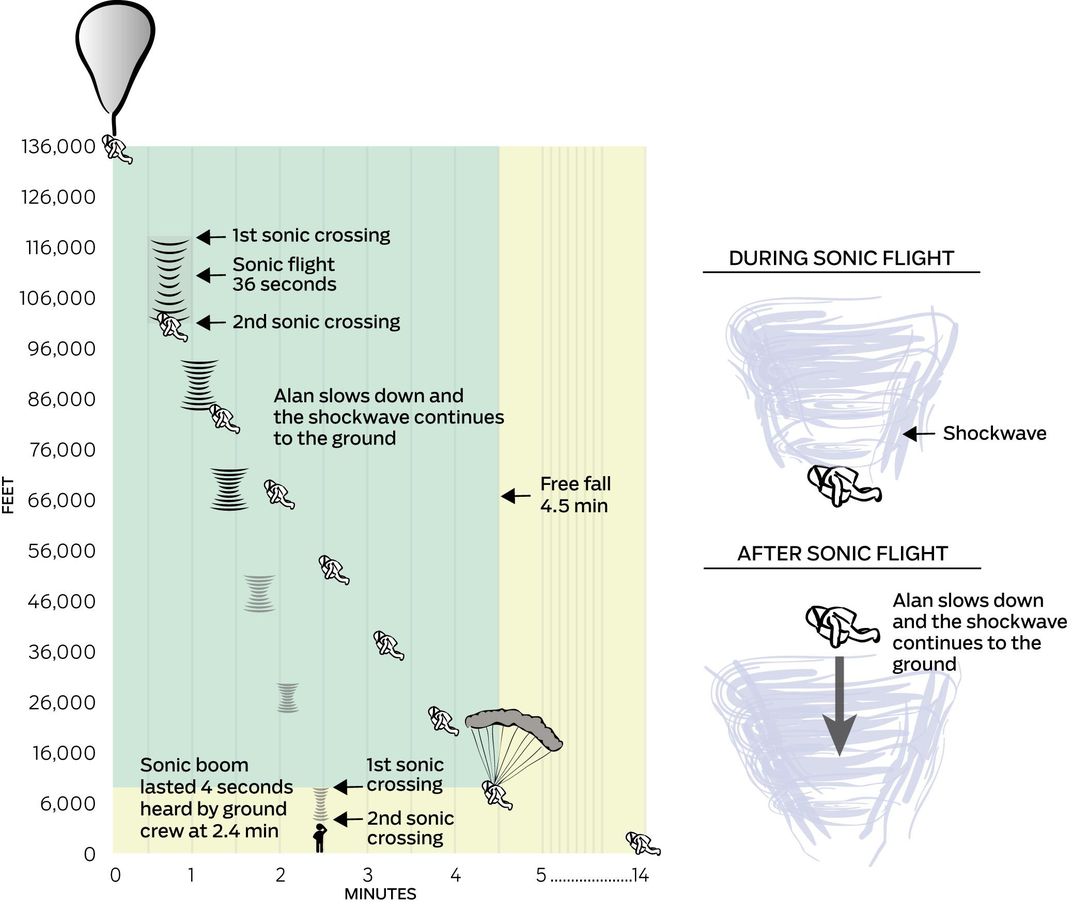The Human Sonic Boom
A skydiver’s shock wave reversed time.
:focal(2254x612:2255x613)/https://tf-cmsv2-smithsonianmag-media.s3.amazonaws.com/filer/b0/86/b086a94f-c5c9-4a11-af12-6bc8c9e55b14/jared_leidich_-_46-1.jpg)
I looked out the window of a Bell Jet Ranger helicopter as it buzzed a lake-like expanse of ground fog at 120 miles per hour. Shimmering tentacles of vapor shot out through the valleys of pecan farms surrounding Roswell, New Mexico. It was October 24, 2014, and 25 miles above my helicopter, Alan Eustace was floating in the stratosphere, suspended from a balloon the size of a football stadium.
Alan is now somewhat famous for performing the highest balloon flight and skydive in history, from 135,900 feet. He was not yet famous on that day. As he reached his final altitude, near the border of Texas, a countdown commenced. At zero, the flight engineer back at Roswell International Air Center in New Mexico sent a signal to the balloon system. A small electric current triggered a release of the cord holding Alan to his balloon. He began to fall through the upper stratosphere.
About 45 seconds after his release, Alan crossed the sound barrier. Two minutes and 22 seconds post-release, a member of the chase crew on the ground hollered over the radio, “We just heard a sonic boom!”
For the next 18 months, I dismissed that boom report as false. We weren’t expecting a boom. We had run a long supersonic dynamics study and consulted some of the world’s leading experts on supersonic flight, who had all said a boom was extremely unlikely. They were wrong. I was wrong.
Fourteen months before Alan made his historic freefall, he and I had visited the NASA Dryden Flight Research Center (now called the Armstrong Flight Research Center) at Edwards Air Force Base in California. With world-renowned balloonist Julian Nott and project manager Sebastian Padilla, we met experts who had overseen the design of dozens of supersonic aircraft. We told them we wanted to drop Alan from 135,000 feet and that our models were suggesting he would fall at around 850 mph, well over the speed of sound.
No one could predict how the supersonic flows would affect Alan or the small stabilizing parachute he would be towing. We left unsure of our ability to keep him stable as he fell. But no one believed he’d create a sonic boom. He was too small, and he would be too high.
More than a year after his dive, we would finally uncover the truth about what the chase crews heard.

After mentioning the sonic boom in an article he wrote for the magazine of University of Central Florida (his alma mater), Alan got an email from a NASA engineer questioning again how a sonic boom would be audible on the ground. Shock waves that cause sonic booms move out in a cone originating from the supersonic object. This makes the perceived boom audible to an observer on the ground on either side of and behind the supersonic flight path but seemingly not in front of it.
Alan forwarded me that email. I couldn’t stop thinking about it. Alan’s flight condition was unique. He was not like a jet flying over an observer. He was traveling at the observers, falling vertically.
Alan also sent the email to Art Thompson, the lead engineer for Felix Baumgartner’s Red Bull Stratos project. Art said Felix had made a sonic boom too. Someone had caught it on a cell phone.
I spoke again with the chase crews who had reported hearing the boom on the ground. “It did not sound like a surface-ground explosion; the sound seemed to travel from the top down, enveloping us, with a deep echo following,” one of them told me. Every member of the crew offered a similar description, all saying the noise seemed to linger. None of them had heard anything like it.
Because supersonic shock waves travel at the speed of sound, we could use the distance between Alan and the ground at the time he broke the sound barrier to predict the time at which the sonic boom would have been heard on the ground below him. We compared that to the time the chase crews called in the boom. They matched up almost exactly.
In uncovering the details of how this boom was possible, we established just how unique that sonic boom was. First we had to deal with the reasoning that Alan’s shock wave would have traveled only behind him. Thompson, an advanced systems engineer with decades of experience with supersonic aircraft, provided an explanation. He said a shock wave doesn’t just disappear when an object slows to subsonic speeds. The wave will depart from the object and continue forward, like the wave from a boat that slows quickly; the wave continues rippling across the water toward the shore. While Alan was traveling at supersonic speeds, he was creating a shock wave. As he slowed, the energy continued toward the ground. We were reminded that Alan was moving toward his observers.
That left the much more vexing question: How did something so small make such a big noise?

Alan broke the sound barrier 33 seconds after releasing from the balloon while he was 119,000 feet above sea level. He crossed back to subsonic speeds 69 seconds after release, at 76,000 feet.
Imagine the sound Alan was making as a constant stream of radio-controlled toy airplanes, launched at a constant interval, flying at the same speed as one another, each carrying a message with a time-stamp. Now imagine Alan as the driver of a convertible automobile launching those little airplanes. Imagine him hitting the gas and exceeding the speed of the little toy planes he was launching.
When the car matched the speed of the toy airplanes, they would stop flying away. If Alan were to drive faster than the toys, the car would overtake them, stringing them out in reverse order behind the car. If the car slowed, the little airplanes would shoot past it. A downstream observer would experience a flow of airplanes punctuated by one section where a whole cloud of airplanes would arrive in a clump. The time-stamps would show the last plane launched had arrived first, and vice versa.
When Alan was traveling exactly at the speed of sound, the shock waves he was creating stayed next to him. As he moved faster, those waves fell behind him. When he slowed down, all the sound and supersonic pressure waves he created passed him.
GPS allowed us to track Alan’s exact location as he fell, and we know the speed of sound, so we can calculate the instant that a supersonic shock wave he was creating should have reached the ground. We could then find the start time and end time that the sound from the supersonic journey reached the surface. Thus, Alan’s 36-second supersonic journey would be heard for just less than four seconds on Earth. This perceived duration of the boom was odd in both its brevity and longevity. It was uniquely short because it was the condensation of over 30 seconds of supersonic flight and remarkably long, because sonic booms from aircraft moving horizontally in respect to the observers last only a second or two (not counting any echo from surrounding geography).
When a jet flies over a point on the ground, only one pressure wave is encountered. For an object moving vertically at near Mach 1 for a substantial amount of time, lots of pressure waves generated across tens of seconds would reach the ground at near the same time, increasing the relative volume and duration of the boom.
Wildly, because Alan was moving faster than the sound he created, the ground crews heard his flight in reverse. The start of his journey was heard last, and the end, first. I can think of no other situation where an event is naturally perceived backwards in this way.
We didn’t consider trying to capture the sonic boom because we’d assumed there wouldn’t be one. Recording what must have been a fascinating noise is reason enough for someone to get up there and do this again.
